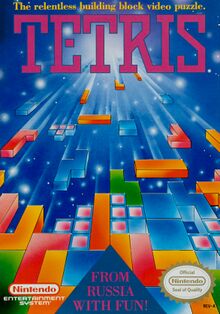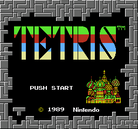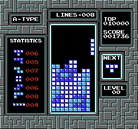Tetris (NES, Nintendo): Difference between revisions
*>DIGITAL No edit summary |
m screenshots |
||
| (30 intermediate revisions by 11 users not shown) | |||
| Line 1: | Line 1: | ||
{{Infobox |title = Tetris | {{Infobox |title = Tetris | ||
|developer = Nintendo | |developer = Nintendo R&D1 | ||
|publisher = Nintendo | |publisher = Nintendo | ||
|released = 1989 | |released = {{Release|US|November, 1989}}{{Release|EU|February 23, 1990}} | ||
|platform = | |platform = Nintendo Entertainment System | ||
|boxart = NES_Tetris_Box_Front.jpg | |boxart = NES_Tetris_Box_Front.jpg | ||
|title-scrn=NES Tetris | |title-scrn = NES Tetris TitleScreen.png | ||
|ingame-scrn=NES Tetris | |ingame-scrn = NES Tetris Gameplay.png | ||
|hard= | |hard = No | ||
| | |system = [[Nintendo Rotation System]] right-handed version | ||
|playfield= | |playfield = 10 × 20 | ||
|preview=1 | |preview = 1 | ||
|hold= | |hold = No | ||
}} | }} | ||
'''''Tetris''''' for Nintendo Entertainment System was released in November, 1989 in North America and published by Nintendo. Unlike [[Tetris (NES, Tengen)|''Tetris'' (NES, Tengen)]], this game has no 2-player mode. | |||
Unlike [[Tetris (NES, Tengen)| | |||
== Details== | == Details== | ||
| Line 22: | Line 21: | ||
[[Rotation system]] is a right-handed [[Nintendo Rotation System]]. | [[Rotation system]] is a right-handed [[Nintendo Rotation System]]. | ||
[[Lock delay]], [[wall kick]], and [[Drop#Hard drop|hard drop]] are not present. | [[Lock delay]], [[wall kick]], and [[Drop#Hard drop|hard drop]] are not present. | ||
[[DAS]] initial delay is 16 frames, and then every 6 frames. | [[DAS]] initial delay is 16 frames, and then every 6 frames through subtraction from the DAS counter. If the DAS counter reaches 16 and the piece cannot shift, nothing is subtracted from the counter. On top of that, the DAS counter is instantly set to 16 if a tap shift is blocked. The DAS counter does not reset to zero when the d-pad returns to neutral, but when left or right is first pressed. | ||
[[Drop#Soft drop|Soft drop]] speed is 1/2G. | [[Drop#Soft drop|Soft drop]] speed is 1/2G. | ||
[[ARE]] is 10 frames; [[line clear]] delay is an additional 20 frames. | [[ARE]] is 10~18 frames depending on the height at which the piece locked; pieces that lock in the bottom two rows are followed by 10 frames of entry delay, and each group of 4 rows above that has an entry delay 2 frames longer than the last. [[line clear]] delay is an additional 17~20 frames depending on the frame that the piece locks; the animation has 5 steps that advance when the global frame counter modulo 4 equals 0. As a consequence, the first step of the line clear animation is not always a set number of frames. | ||
DAS charging is completely dead during ARE and line clear. While tapping or changing direction during active time would reset the counter, inputting left or right during ARE or the line clear animation has no effect on the value of the counter. This means that any DAS charge left over from the previous piece can be redirected during ARE. | |||
The randomizer features a slight protection against direct repetition. The first roll generates a value 0-7 and will accept and deal on any value other than the previous piece dealt or the dummy value of 7. The piece history is initially empty. If the first roll fails, it progresses to a second roll that generates a value 0-6 and deals that piece. | |||
The following table of [[Drop#Gravity|gravity]] speeds was observed and later found to be stored at $898E (offset $099E in the iNES format ROM): | The following table of [[Drop#Gravity|gravity]] speeds was observed and later found to be stored at $898E (offset $099E in the iNES format ROM): | ||
{| | {| class="wikitable" | ||
! Level || | ! Level || Frames per Gridcell | ||
|- | |- | ||
| 00 || 48 | | 00 || 48 | ||
| Line 61: | Line 63: | ||
|} | |} | ||
In Marathon (called A-TYPE), when the player line clear (''startLevel'' | In Marathon (called A-TYPE), when the player line clear (''startLevel'' × 10 + 10) or max(100, (''startLevel'' × 10 - 50)) lines, whatever comes first, the level advances by 1. | ||
After this, the level advances by 1 for every 10 lines. | After this, the level advances by 1 for every 10 lines. | ||
* Start at level 5, advance to level 6 at 60 lines, advance to level 7 at 70 lines. | * Start at level 5, advance to level 6 at 60 lines, advance to level 7 at 70 lines. | ||
* Start at level 12, advance to level 13 at 100 lines, advance to level 14 at 110 lines. | * Start at level 12, advance to level 13 at 100 lines, advance to level 14 at 110 lines. | ||
* Start at level 16, advance to level 17 at 110 lines, advance to level 18 at 120 lines. | |||
== Differences in the PAL release== | |||
The PAL NES is specified to run at 50.0070 frames per second. Rather than play as a slower version of the NTSC original, the game was rebalanced with a modified set of frame timings for its PAL release. | |||
[[DAS]] initial delay is 12 frames, and then every 4 frames through subtraction from the DAS counter. The behavior of [[ARE]] and [[line clear]] appear to be unchanged. The modified gravity table attempts to follow the same progression, but lack of resolution causes some significant changes in the speed of later levels; given that Levels 08 onward are each 1 frame faster than the original NTSC speedcurve, the game reaches speeds of 1G at Level 19 rather than Level 29. | |||
< | Although the improved DAS facilitates play at 1G speeds without rapid tapping to some extent, prolonged survival remains dubious; play is still restricted to the bottom rows of the playfield, and the high gravity coupled with a faster (and therefore harder to "skillstop") DAS make it incredibly difficult to maintain a clean stack. On March 8, 2021, EricICX became the first person to [[maxout]] the PAL version with a score of 1,096,300 points.<ref>https://www.reddit.com/r/Tetris/comments/m18uwt/first_ever_maxout_on_pal_version_of_nes_tetris_by/</ref> | ||
{| class="wikitable" | |||
! Level || Frames per Gridcell | |||
|- | |||
| 00 || 36 | |||
|- | |||
| 01 || 32 | |||
|- | |||
| 02 || 29 | |||
|- | |||
| 03 || 25 | |||
|- | |||
| 04 || 22 | |||
|- | |||
| 05 || 18 | |||
|- | |||
| 06 || 15 | |||
|- | |||
| 07 || 11 | |||
|- | |||
| 08 || 7 | |||
|- | |||
| 09 || 5 | |||
|- | |||
| 10–12 || 4 | |||
|- | |||
| 13–15 || 3 | |||
|- | |||
| 16–18 || 2 | |||
|- | |||
| 19+ || 1 | |||
|} | |||
== See also == | == See also == | ||
*[[Scoring]] | *[[Scoring]] | ||
== References == | |||
<references /> | |||
== External links == | == External links == | ||
*[ | *[https://web.archive.org/web/20110203064541/http://www.tetrismaster.com/ Archive of some early NES Tetris high scores with videos] | ||
*[http://meatfighter.com/nintendotetrisai/#The_Mechanics_of_Nintendo_Tetris Nintendo Tetris AI project, including a detailed (assembly-level) description of the game's mechanics] | |||
*[http:// | |||
{{Nintendo games}} | |||
[[Category: | [[Category:Official Tetris games]] | ||
[[Category:Nintendo Entertainment System games]] | |||
Latest revision as of 09:01, 9 July 2024
| Tetris | |
|---|---|
 | |
| Developer(s) | Nintendo R&D1 |
| Publisher(s) | Nintendo |
| Platform(s) | Nintendo Entertainment System |
| Release |
|
| Gameplay info | |
| Next pieces | 1 |
| Playfield size | 10 × 20 |
| Hold piece | No |
| Hard drop | No |
| Rotation system | Nintendo Rotation System right-handed version |
Tetris for Nintendo Entertainment System was released in November, 1989 in North America and published by Nintendo. Unlike Tetris (NES, Tengen), this game has no 2-player mode.
Details
The Nintendo Entertainment System is specified to run at 60.0988 frames per second.
Rotation system is a right-handed Nintendo Rotation System. Lock delay, wall kick, and hard drop are not present. DAS initial delay is 16 frames, and then every 6 frames through subtraction from the DAS counter. If the DAS counter reaches 16 and the piece cannot shift, nothing is subtracted from the counter. On top of that, the DAS counter is instantly set to 16 if a tap shift is blocked. The DAS counter does not reset to zero when the d-pad returns to neutral, but when left or right is first pressed. Soft drop speed is 1/2G. ARE is 10~18 frames depending on the height at which the piece locked; pieces that lock in the bottom two rows are followed by 10 frames of entry delay, and each group of 4 rows above that has an entry delay 2 frames longer than the last. line clear delay is an additional 17~20 frames depending on the frame that the piece locks; the animation has 5 steps that advance when the global frame counter modulo 4 equals 0. As a consequence, the first step of the line clear animation is not always a set number of frames. DAS charging is completely dead during ARE and line clear. While tapping or changing direction during active time would reset the counter, inputting left or right during ARE or the line clear animation has no effect on the value of the counter. This means that any DAS charge left over from the previous piece can be redirected during ARE.
The randomizer features a slight protection against direct repetition. The first roll generates a value 0-7 and will accept and deal on any value other than the previous piece dealt or the dummy value of 7. The piece history is initially empty. If the first roll fails, it progresses to a second roll that generates a value 0-6 and deals that piece.
The following table of gravity speeds was observed and later found to be stored at $898E (offset $099E in the iNES format ROM):
| Level | Frames per Gridcell |
|---|---|
| 00 | 48 |
| 01 | 43 |
| 02 | 38 |
| 03 | 33 |
| 04 | 28 |
| 05 | 23 |
| 06 | 18 |
| 07 | 13 |
| 08 | 8 |
| 09 | 6 |
| 10–12 | 5 |
| 13–15 | 4 |
| 16–18 | 3 |
| 19–28 | 2 |
| 29+ | 1 |
In Marathon (called A-TYPE), when the player line clear (startLevel × 10 + 10) or max(100, (startLevel × 10 - 50)) lines, whatever comes first, the level advances by 1. After this, the level advances by 1 for every 10 lines.
- Start at level 5, advance to level 6 at 60 lines, advance to level 7 at 70 lines.
- Start at level 12, advance to level 13 at 100 lines, advance to level 14 at 110 lines.
- Start at level 16, advance to level 17 at 110 lines, advance to level 18 at 120 lines.
Differences in the PAL release
The PAL NES is specified to run at 50.0070 frames per second. Rather than play as a slower version of the NTSC original, the game was rebalanced with a modified set of frame timings for its PAL release.
DAS initial delay is 12 frames, and then every 4 frames through subtraction from the DAS counter. The behavior of ARE and line clear appear to be unchanged. The modified gravity table attempts to follow the same progression, but lack of resolution causes some significant changes in the speed of later levels; given that Levels 08 onward are each 1 frame faster than the original NTSC speedcurve, the game reaches speeds of 1G at Level 19 rather than Level 29.
Although the improved DAS facilitates play at 1G speeds without rapid tapping to some extent, prolonged survival remains dubious; play is still restricted to the bottom rows of the playfield, and the high gravity coupled with a faster (and therefore harder to "skillstop") DAS make it incredibly difficult to maintain a clean stack. On March 8, 2021, EricICX became the first person to maxout the PAL version with a score of 1,096,300 points.[1]
| Level | Frames per Gridcell |
|---|---|
| 00 | 36 |
| 01 | 32 |
| 02 | 29 |
| 03 | 25 |
| 04 | 22 |
| 05 | 18 |
| 06 | 15 |
| 07 | 11 |
| 08 | 7 |
| 09 | 5 |
| 10–12 | 4 |
| 13–15 | 3 |
| 16–18 | 2 |
| 19+ | 1 |
See also
References
External links
- Archive of some early NES Tetris high scores with videos
- Nintendo Tetris AI project, including a detailed (assembly-level) description of the game's mechanics
| ||||||||||||||

